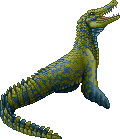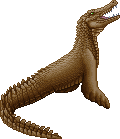Mottled and Silt Seroiles #864-865
Posted: March 17th, 2018, 12:03:46 am
Man, I JUST filled my egg slots. 
Mottle Seroile

This green egg is smooth and leathery.


Silt Seroile

This brown egg is smooth and leathery.


Descriptions for both (hatchling, adult, general):
Mottle Seroile

This green egg is smooth and leathery.


Silt Seroile

This brown egg is smooth and leathery.


Descriptions for both (hatchling, adult, general):
Spoiler
Young seroile chirp repeatedly, much like birds, before they hatch from their eggs. As they grow, their repertoire of noises starts to include grunts, clicks, growls, barks, and other varied calls that can be strung together to convey ideas to other seroile. They continue to communicate verbally throughout their lives, and develop unique “songs” that they can use to identify one another. Unfortunately, these noisy creatures are not the most welcoming companions, as they spend much of their time darting around the water and tend to snap at anything that upsets or confuses them. Magi charged with caring for a seroile can train them to a degree, and may use them as aquatic guides and adventuring companions. They are quite crafty creatures, and should they choose, may show a magi how to navigate a crowded waterway.
Seroile are calmer in disposition than crocodiles but more patient than aquatic mammals like seals, and with time and many training sessions, they may allow a human companion to swim alongside them. Seroile have many sharp teeth and powerful jaw muscles, but they can also be surprisingly dexterous, capable of picking up glass orbs without damaging them. A trained seroile is an excellent companion for exploring sunken temples, as they can hold their breath for up to half an hour and slip through tight spaces with ease and grace. Magi traveling along waterways often take a seroile companion along to scout ahead and bring back artifacts they find. Some magi will train their seroile to bring back specific items depending on what they see; a branch, for instance, might mean a forest, a leaf a settlement with an open port, or a polished stone some sort of danger. Of course, a less well-trained seroile will most likely bring back whatever catches its eye. Seroile are natural adventurers, and love to visit new places. Magi may reward their companion for their help by bringing back some memento from the journey that their seroile will stash in a little treasure hoard in their pool at the Keep.
Though smaller than the leviathans and other sea monsters that occupy large waterways, seroile are not to be underestimated. Bulls can reach weights of over a thousand pounds, and both sexes have powerful jaws that will make short work of an unwary explorer’s canoe paddle. They are most often found in tropical regions, silt seroile to the east in Raza, and mottled seroile to the west, in Tetzcotal. There they may live in a variety of aquatic habitats, ranging far upstream, or venturing to the mangrove swamps that surround some coastal channels. Most often, however, seroile are found in murky rivers where they will wait for prey to pass near, then burst out from behind some debris or vegetation to make chase. They can swim surprisingly fast and are quite agile thanks to their long front flippers. The seroile’s head is packed with sensitive nerves that can detect tremors in the water, and they will pursue almost anything that comes their way. The only creatures the seroile will not eat are hydras, serpents, and dragons.
Seroile are calmer in disposition than crocodiles but more patient than aquatic mammals like seals, and with time and many training sessions, they may allow a human companion to swim alongside them. Seroile have many sharp teeth and powerful jaw muscles, but they can also be surprisingly dexterous, capable of picking up glass orbs without damaging them. A trained seroile is an excellent companion for exploring sunken temples, as they can hold their breath for up to half an hour and slip through tight spaces with ease and grace. Magi traveling along waterways often take a seroile companion along to scout ahead and bring back artifacts they find. Some magi will train their seroile to bring back specific items depending on what they see; a branch, for instance, might mean a forest, a leaf a settlement with an open port, or a polished stone some sort of danger. Of course, a less well-trained seroile will most likely bring back whatever catches its eye. Seroile are natural adventurers, and love to visit new places. Magi may reward their companion for their help by bringing back some memento from the journey that their seroile will stash in a little treasure hoard in their pool at the Keep.
Though smaller than the leviathans and other sea monsters that occupy large waterways, seroile are not to be underestimated. Bulls can reach weights of over a thousand pounds, and both sexes have powerful jaws that will make short work of an unwary explorer’s canoe paddle. They are most often found in tropical regions, silt seroile to the east in Raza, and mottled seroile to the west, in Tetzcotal. There they may live in a variety of aquatic habitats, ranging far upstream, or venturing to the mangrove swamps that surround some coastal channels. Most often, however, seroile are found in murky rivers where they will wait for prey to pass near, then burst out from behind some debris or vegetation to make chase. They can swim surprisingly fast and are quite agile thanks to their long front flippers. The seroile’s head is packed with sensitive nerves that can detect tremors in the water, and they will pursue almost anything that comes their way. The only creatures the seroile will not eat are hydras, serpents, and dragons.